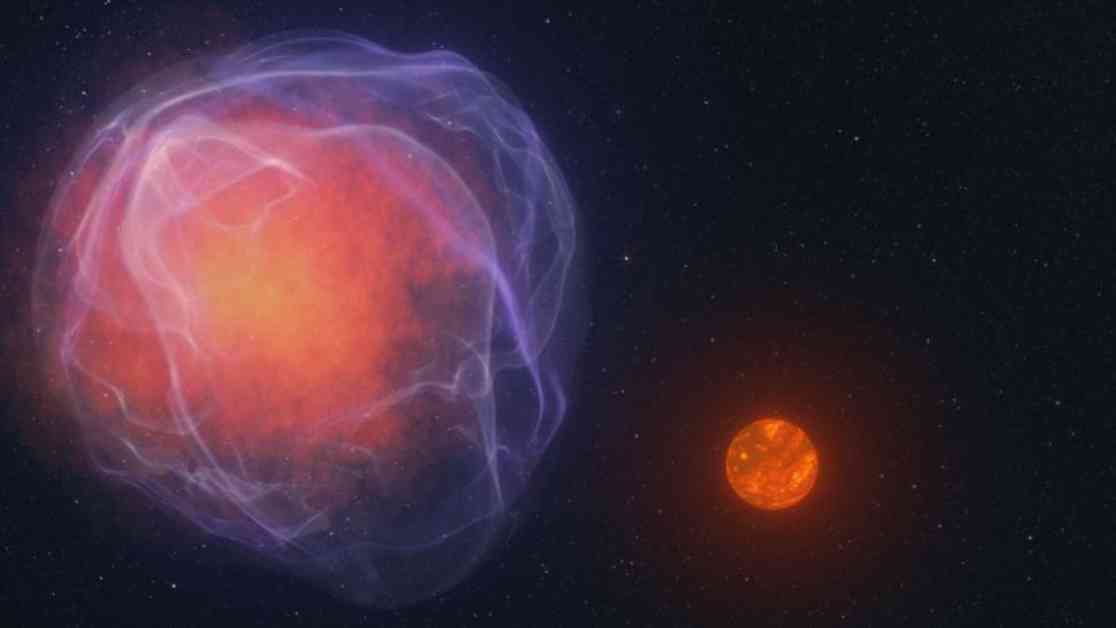An object recently observed speeding through the Milky Way has left scientists baffled and intrigued by its unusual characteristics. The fast-moving object, dubbed CWISE J124909.08+362116.0 or J1249+36 for short, was initially detected by citizen scientists participating in the Backyard Worlds: Planet 9 project. Moving at an astonishing speed of about 1.3 million miles per hour, this mysterious object has the potential to escape the gravitational pull of our galaxy and venture into intergalactic space, a feat that has captured the attention of researchers and astronomers alike.
### Unveiling a Hypervelocity Star
The discovery of J1249+36 is particularly significant as it could be the first known “hypervelocity” very low-mass star ever identified. Hypervelocity stars are an extremely rare phenomenon, first theorized in 1988 and subsequently discovered in 2005. These stars exhibit velocities that allow them to break free from the gravitational constraints of their host galaxies, offering valuable insights into the dynamics of stellar evolution and galactic interactions.
The object’s rapid speed, equivalent to approximately 0.1% of the speed of light, immediately caught the attention of researchers and citizen scientists combing through the data collected by NASA’s Wide-field Infrared Survey Explorer mission. While the star’s low mass initially posed a challenge in its classification—raising questions about whether it was a low-mass star or a brown dwarf—the use of multiple telescopes and spectrographic data helped shed light on its composition and trajectory.
### The Origin of J1249+36
One possible explanation for the origin of J1249+36 involves its potential connection to a white dwarf star. In such scenarios, the white dwarf’s gravitational influence on its companion star can lead to mass transfer and eventual explosive events like novae or supernovae. These cataclysmic events can impart enough energy to propel the companion star at high velocities, sending it on a trajectory that could eventually lead it out of the Milky Way.
Alternatively, J1249+36 may have originated from a globular cluster—a densely packed grouping of stars with a central black hole. Interactions within globular clusters, particularly those involving black hole binaries, can result in the ejection of stars at high speeds. Simulations conducted by researchers suggest that such three-body interactions could plausibly account for the trajectory observed in J1249+36, offering a compelling explanation for its rapid movement through the galaxy.
### Unraveling the Mysteries of J1249+36
Despite the tantalizing clues provided by the star’s composition and velocity, numerous questions remain regarding the true nature and origins of J1249+36. The object’s distinctive chemical composition, elemental abundances, and kinematic properties hold the key to unlocking its past and unraveling the cosmic forces that set it on its current path towards intergalactic space.
By studying the elemental fingerprint of J1249+36, astronomers hope to discern the star’s origins and shed light on the mechanisms that propelled it to such extraordinary velocities. The presence of heavy elements generated by white dwarf explosions or the unique elemental signatures associated with stars in globular clusters could provide crucial insights into the star’s history and trajectory, offering a glimpse into the ancient cosmic environments that shaped its journey.
### The Significance of Hypervelocity Stars
The discovery of J1249+36 not only showcases the remarkable capabilities of citizen scientists in contributing to cutting-edge astronomical research but also underscores the importance of studying hypervelocity stars in unraveling the mysteries of galactic dynamics and stellar evolution. These high-speed stars offer a unique window into the processes that govern the formation, migration, and interactions of celestial bodies within galaxies, providing valuable clues about the history and evolution of our universe.
As astronomers continue to probe the origins and trajectories of hypervelocity stars like J1249+36, they aim to uncover a broader population of high-velocity, low-mass objects that have undergone extreme accelerations. By piecing together the cosmic puzzle of these runaway stars, researchers hope to gain a deeper understanding of the forces that shape our galactic neighborhood and the intricate dance of celestial bodies that populate the vast expanse of space.
### Prospects for Future Discoveries
The detection of J1249+36 marks a significant milestone in the study of hypervelocity stars and opens up new avenues for exploring the hidden realms of our galaxy. By tracing the star’s trajectory back in time, astronomers may unveil clusters of stars and globular formations that have remained elusive to traditional observation methods. This reverse mapping approach could lead to the identification of undiscovered stellar populations and provide valuable insights into the dynamics of galactic evolution and star formation processes.
Looking ahead, researchers are eager to delve deeper into the mysteries surrounding J1249+36 and unearth further clues about its enigmatic origins. By leveraging advanced telescopic observations, spectroscopic analyses, and computational simulations, astronomers hope to unravel the complex web of interactions that shaped this high-speed star and shed light on the cosmic forces that propelled it on its remarkable journey through the Milky Way.
In conclusion, the discovery of J1249+36 represents a testament to the collaborative efforts of citizen scientists, researchers, and astronomers in unraveling the mysteries of the universe. As we continue to probe the depths of space and explore the cosmic wonders that surround us, each new discovery brings us closer to unlocking the secrets of the cosmos and expanding our understanding of the vast and intricate tapestry of the universe.


































































